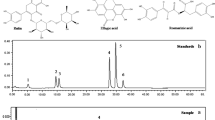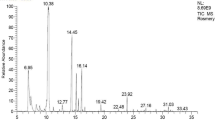Abstract
The aim of this study was to evaluate the antimutagenic and antigenotoxic potential of grape juice concentrate in rodent organs exposed to cadmium chloride intoxication. A total of 15 Wistar rats were distributed into three groups (n = 5), as follows: control group (CTRL; nontreated group), cadmium group (Cd), and cadmium-grape juice group (Cd + GJ). Exposed animals received intraperitoneal injection of cadmium chloride (1.2 mg/kg body weight) diluted in water and, after 15 days, Cd + GJ group received grape juice concentrate for 15 days, by gavage (0.8 mL, 1.18 mg of polyphenols kg−1 day−1). Grape juice concentrate was able to decrease genotoxic effects induced by cadmium in peripheral blood and liver cells as depicted by single cell gel (comet) and micronucleus assays. A decrease for anti-8-hydroxy-20-deoxyguanosine (8OHdG) expression in hepatocytes of animals exposed to cadmium and treated with grape juice concentrate was also detected. Higher CuZn-SOD activity was observed in liver cells of the Cd + GJ group. No remarkable differences were seen regarding Mn-SOD activity among groups. Taken together, our results demonstrate that grape juice concentrate was able to exert antimutagenic and antigenotoxic activities in blood and liver cells of rats exposed to cadmium.







Similar content being viewed by others
References
Aguiar O Jr, Gollücke AP, de Moraes BB, Pasquini G, Catharino RR, Riccio MF, Ihara SS, Ribeiro DA (2011) Grape juice concentrate prevents oxidative DNA damage in peripheral blood cells of rats subjected to a high-cholesterol diet. Br J Nutr 105(5):694–702
Akerstrom M, Barregard L, Lundh T, Sallsten G (2013) The relationship between cadmium in kidney and cadmium in urine and blood in an environmentally exposed population. Toxicol Appl Pharmacol 268(3):286–293
Anetor JI (2012) Rising environmental cadmium levels in developing countries: threat to genome stability and health. Niger J Physiol Sci 27:103–115
Angermüller S, Islinger M, Völkl A (2009) Peroxisomes and reactive oxygen species, a lasting challenge. Histochem Cell Biol 131(4):459–463
Arora M, Weuve J, Schwartz J, Wright RO (2008) Association of environmental cadmium exposure with pediatric dental caries. Environ Health Perspect 116(6):821–825
Benitez DA, Hermoso MA, Pozo-Guisado E, Fernández-Salgueiro PM, Castellón EA (2009) Regulation of cell survival by resveratrol involves inhibition of NFκB-regulated gene expression in prostate cancer cells. Prostate 69:1045–1054
Bernhoft RA (2013) Cadmium toxicity and treatment. Sci World J 2013:394652. doi:10.1155/2013/394652
Bertin G, Averbeck D (2006) Cadmium: cellular effects, modifications of biomolecules, modulation of DNA repair and genotoxic consequences (a review). Biochimie 88(11):1549–1559
Borges LP, Brandão R, Godoi B, Nogueira CW, Zeni G (2008) Oral administration of diphenyldiselenide protects against cadmium-induced liver damage in rats. Chem Biol Interact 171:15–25
Bzróska MM, Moniuszko-Jaloniuk J, Pilat-Marcinkiewicz B, Sawicki B (2003) Liver and kidney function and histology in rats exposed to cadmium and ethanol. Alcohol 38(1):2–10
Casalino E, Calzaretti G, Sblano C, Landriscina V, FeliceTecce M, Landriscina C (2002) Antioxidant effect of hydroxytyrosol (DPE) and Mn2+ in liver of cadmium-intoxicated rats. Comp Biochem Physiol C Toxicol Pharmacol 133(4):625–632
Çelik A, Büyükakilli B, Cimen B, Taşdelen B, Oztürk MI, Eke D (2009) Assessment of cadmium genotoxicity in peripheral blood and bone marrow tissues of male Wistar rats. Toxicol Mech Methods 19(2):135–140
Colin D, Gimazane A, Lizard G, Izard JC, Solary E, Latruffe N, Delmas D (2009) Effects of resveratrol analogs on cell cycle progression, cell cycle associated proteins and 5 fluoro-uracil sensitivity in human derived colon cancer cells. Int J Cancer 124:2780–2788
Degrandi TH, de Oliveira IM, d'Almeida GS, Garcia CR, Villela IV, Guecheva TN, Rosa RM, Henriques JA (2010) Evaluation of the cytotoxicity, genotoxicity and mutagenicity of diphenyl ditelluride in several biological models. Mutagenesis 25(3):257–69
de Jesus GP, Ribeiro FA, de Moura CF, Gollucke AP, Oshima CT, Ribeiro DA (2014) Anti-tumor activity of grape juice concentrate in the rat tongue two-stage initiation-promotion protocol induced by 4-nitroquinoline 1-oxide. Toxicol Mech Methods 24(4):276–283
Edwards JR, Kolman K, Lamar PC, Chandar N, Fay MJ, Prozialeck WC (2013) Effects of cadmium on the sub-cellular localization of β-catenin and β-catenin-regulated gene expression in NRK-52E cells. Biometals 26(1):33–42
Engström A, Michaëlsson K, Suwazono Y, Wolk A, Vahter M, Akesson A (2011) Long-term cadmium exposure and the association with bone mineral density and fractures in a population-based study among women. J Bone Miner Res 26(3):486–495
Eybl V, Kotyzova D, Koutensky J (2006) Comparative study of natural antioxidants—curcumin, resveratrol and melatonin—in cadmium-induced oxidative damage in mice. Toxicology 225:150–156
Fahmi AI, El-Shehawi AM, Nagaty MA (2013) Antioxidant and antimutagenic activities of taif grape (Vitis vinifera) cultivars. Am J Biochem Biotechnol 9(2):102–117
Ferguson LR (2001) Role of plant polyphenols in genomic stability. Mutat Res 475(1–2):89–111
Filipič M (2012) Mechanisms of cadmium induced genomic instability. Mutat Res 733(1–2):69–77
Filipič M, Hei TK (2004) Mutagenicity of cadmium in mammalian cells: implication of oxidative DNA damage. Mutat Res 546(1–2):81–91
Freeman JA, Johnson JV, Yost RA, Kuehl DW (1994) Gas-phase ion-molecule reactions: a model for the determination of biologically reactive electrophilic contaminants in the environment. Anal Chem 66(11):1902–1910
Frémont L (2000) Mini review: biological effects of resveratrol. Life Sci 66(8):663–673
Gollücke APB (2010) Recent applications of grape polyphenols in foods, beverages and supplements. Recent Patents Food Nutr Agric 2:105–109
Gollücke AP, Souza JC, Tavares DQ (2008) (+)-Catechin and (−)-epicatechin levels of concentrated and ready-to-drink grape juices through storage. Int J Food Sci Technol 43(10):1855–1859
Hartwig A (2010) Mechanisms in cadmium-induced carcinogenicity: recent insights. Biometals 23(5):951–960
Hasler CM, Bloch AS, Thomson CA, Enrione E, Manning C (2009) Position of the American dietetic association: functional foods. J Am Diet Assoc 109(4):735–746
Hengstler JG, Bolm-Audorff U, Faldum A, Janssen K, Reifenrath M, Götte W, Jung D, Mayer-Popken O, Fuchs J, Gebhard S, Bienfait HG, Schlink K, Dietrich C, Faust D, Epe B, Oesch F (2003) Occupational exposure to heavy metals: DNA damage induction and DNA repair inhibition prove co-exposures to cadmium, cobalt and lead as more dangerous than hitherto expected. Carcinogenesis 24(1):63–73
Hodkova A, Kotyzova D, Brtko J, Eybl V (2008) Influence of curcumin, resveratrol and sodium selenite on thioredoxin reductase, glutathione peroxidase and iodothyronine-5-deiodinase activity in rats-interaction with cadmium. Toxicol Lett 180S:S32–S246
Järup L, Ǻkesson A (2009) Current status of cadmium as an environmental health problem. Toxicol Appl Pharmacol 238:201–208
Jihen EH, Sonia S, Fatima H, Mohamed Tahar S, Abdelhamid K (2011) Interrelationships between cadmium, zinc and antioxidants in the liver of the rat exposed orally to relatively high doses of cadmium and zinc. Ecotoxicol Environ Saf 74(7):2099–2104
Jurczuk M, Moniuszko-Jakoniuk J, Rogalska J (2006) Evaluation of oxidative stress in hepatic mitochondria of rats exposed to cadmium and ethanol. Pol J Environ Stud 15(6):853–860
Klaunig JE, Kamendulis LM, Hocevar BA (2010) Oxidative stress and oxidative damage in carcinogenesis. Toxicol Pathol 38(1):96–109
Lindahl T, Wood RD (1999) Quality control by DNA repair. Science 286(5446):1897–1905
Liu J, Qu W, Kadiiska MB (2009) Role of oxidative stress in cadmium toxicity and carcinogenesis. Toxicol Appl Pharmacol 238:209–214
Luna C, Li G, Liton PB, Qiu J, Epstein DL, Challa P, Gonzalez P (2009) Resveratrol prevents the expression of glaucoma markers induced by chronic oxidative stress in trabecular meshwork cells. Food Chem Toxicol 47:198–204
Lundin C, North M, Erixon K, Walters K, Jenssen D, Goldman AS, Helleday T (2005) Methyl methanesulfonate (MMS) produces heat-labile DNA damage but no detectable in vivo DNA double-strand breaks. Nucleic Acids Res 33(12):3799–3811
Mikhailova MV, Littlefield NA, Hass BS, Poirier LA, Chou MW (1997) Cadmium-induced 8-hydroxydeoxyguanosine formation, DNA strand breaks and antioxidant enzyme activities in lymphoblastoid cells. Cancer Lett 115(2):141–148
Nordberg GF (2009) Historical perspectives on cadmium toxicology. Toxicol Appl Pharmacol 238:192–200
Ognjanović BI, Marković SD, Pavlović SZ, Zikić RV, Stajn AS, Saicić ZS (2008) Effect of chronic cadmium exposure on antioxidant defense system in some tissues of rats: protective effect of selenium. Physiol Res 57(3):403–411
Paiotti AP, Neto RA, Marchi P, Silva RM, Pazine VL, Noguti J, Pastrelo MM, Gollücke AP, Miszputen SJ, Ribeiro DA (2013) The anti-inflammatory potential of phenolic compounds in grape juice concentrate (G8000™) on 2,4,6-trinitrobenzene sulphonic acid-induced colitis. Br J Nutr 110(6):973–980
Palus J, Rydzynski K, Dziubaltowska E, Wyszynska K, Natarajan AT, Nilsson R (2003) Genotoxic effects of occupational exposure to lead and cadmium. Mutat Res 540(1):19–28
Panjehpour M, Bayesteh M (2008) The cytotoxic effects of cadmium chloride on the human lung carcinoma (Calu-6) cell line. Res Pharm Sci 3(2):113–117
Pires VC, Gollücke AP, Ribeiro DA, Lungato L, D’Almeida V, Aguiar O Jr (2013) Grape juice concentrate protects reproductive parameters of male rats against cadmium-induced damage: a chronic assay. Br J Nutr 110(11):2020–2029
Prozialeck WC, Edwards JR, Vaidya VS, Bonventre JV (2009) Preclinical evaluation of novel urinary biomarkers of cadmium nephrotoxicity. Toxicol Appl Pharmacol 238(3):301–305
Ramesh B, Satakopan VN (2010) Antioxidant activities of hydroalcoholic extract of Ocimum sanctum against cadmium induced toxicity in rats. Indian J Clin Biochem 25(3):307–310
Rho KA, Kim MK (2006) Effects of different grape formulations on antioxidative capacity, lipid peroxidation and oxidative DNA damage in aged rats. J Nutr Sci Vitaminol (Tokyo) 52(1):33–46
Ribeiro DA, Grilli DG, Salvadori DM (2008) Genomic instability in blood cells is able to predict the oral cancer risk: an experimental study in rats. J Mol Histol 39:481–486
Satarug S, Garret SH, Sens MA, Sens DA (2010) Cadmium, Environmental exposure and health outcomes. Environ Health Perspect 118(2):182–190
The Comet Assay International Validation Management Team (2013) Report of the JaCVAM initiative international pre-validation studies of the in vivo rodent alkaline Comet assay for the detection of genotoxic carcinogens, Ver 1.4. OECD - Organisation for Economic Co-operation and Development. http://www.oecd.org/env/ehs/testing/Come%20assay%20revised%20pre-validation%20report%202013.pdf. Accessed 15 Apr 2014
Thijssen S, Cuypers A, Maringwa J, Smeets K, Horemans N, Lambrichts I, Van Kerkhove E (2007) Low cadmium exposure triggers a biphasic oxidative stress response in mice kidneys. Toxicology 236(1–2):29–41
Tice RR, Agurell E, Anderson D, Burlinson B, Hartmann A, Kobayashi H, Miyamae Y, Rojas E, Ryu JC, Sasaki YF (2000) Single cell gel/comet assay: guidelines for in vitro and in vivo genetic toxicology testing. Environ Mol Mutagen 35(3):206–221
Yalçin E, Oruç E, Cavuşoğlu K, Yapar K (2010) Protective role of grape seed extract against doxorubicin-induced cardiotoxicity and genotoxicity in albino mice. J Med Food 13(4):917–925
Yu RA, He LF, Chen XM (2007) Effects of cadmium on hepatocellular DNA damage, proto-oncogene expression and apoptosis in rats. Biomed Environ Sci 20(2):146–153
Acknowledgments
This work was supported by CNPq (National Counsel of Technological and Scientific Development). CFGM and DAR are fellowships from CNPq. GPPJ and VGPS are recipients from Coordination for the Improvement of Higher Level-or Education-Personnel (CAPES).
Conflict of interest
None declared.
Author information
Authors and Affiliations
Corresponding author
Additional information
Responsible editor: Philippe Garrigues
Rights and permissions
About this article
Cite this article
de Moura, C.F.G., Ribeiro, F.A.P., Pacheco de Jesus, G.P. et al. Antimutagenic and antigenotoxic potential of grape juice concentrate in blood and liver of rats exposed to cadmium. Environ Sci Pollut Res 21, 13118–13126 (2014). https://doi.org/10.1007/s11356-014-3257-1
Received:
Accepted:
Published:
Issue Date:
DOI: https://doi.org/10.1007/s11356-014-3257-1




